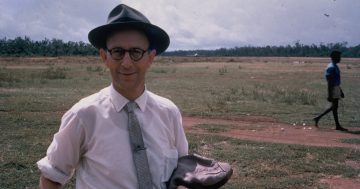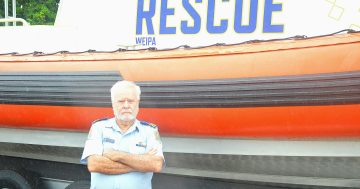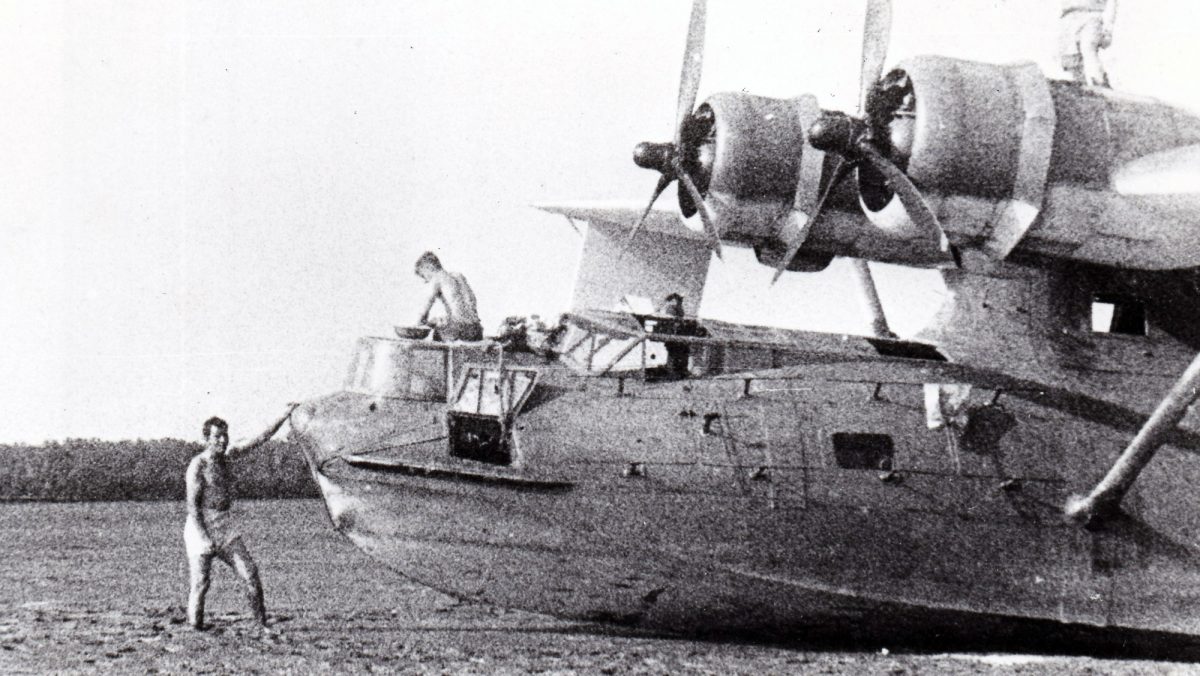
The RAAF Catalina A24-2 crew waiting for the incoming tide at the Pennefather River. Photo by Ron Francis, courtesy of David Vincent, author of the Catalina Chronicle.
On September 17 1942, 1st Lieutenant Claude Burcky and his crew of eight men from the 93rd Bombardment Squadron (known as the Gypsy 93rd), 19th Bombardment Group, United States Army Air Force (USAAF), were returning in their B-17E Flying Fortress bomber from a bombing mission to Rabaul in the south-west Pacific when – according to a later report – they were unable to land at either Port Moresby or Horn Island to refuel, due to enemy action and poor weather conditions.
The squadron was based at Hoevet Airfield near Mareeba. B-17E serial number 41-2650 was one of 512 Mark E four-engined bombers manufactured by the Boeing Airplane Company.
When he was rescued, the pilot recounted the events leading up to the crash:
We had been on a mission and were to return to Port Moresby but the drome [aerodrome] had been bombed by a Jap intruder plane and when we arrived they would not light up the strip so we decided to fly to Horn Island but could not locate that either so we became lost and with thick cloud and the fuel running out decided to bail out and hope we could find land and safety.
We did not know if we were over land or sea at the time.
The navigator went out first then all the rest of the crew. Eight of us located each other near the crash site but we could not find the navigator.
Four of us had injuries in the landing and four were OK.
We decided to split up with the four fit men to try and find help and the injured to find their way to the coast that we had seen as we came through the clouds on our chutes.
The crew parachuted into the swamp and forest country about six kilometres south of the Pennefather River near the headwaters of Nomenade Creek and the plane crashed and broke up on impact.
The remains of the bomber are located adjacent to and in a swamp at approximately Latitude 12° 18’ 13” South and 141° 45’ 57” East (WGS 84).
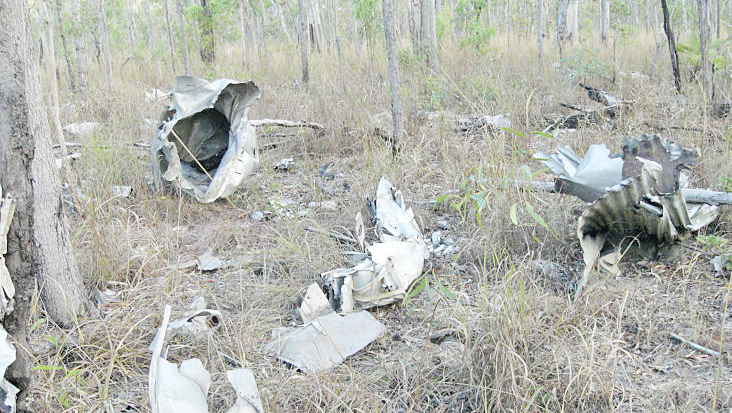
Remains in the bush near Pennefather River.
Crew members who landed safely included First Lieutenant Claude N. Burcky (pilot), Second Lieutenants Gus Rapisardi (co-pilot) and Donald C. Miller (bombardier), Sergeants George W. Schmid (engineer), Lawrence Johnson (radio operator), Norris T. Reynolds (gunner), Lloyd H. Chamberlain (gunner), and Corporal John W. Naglich (gunner).
Missing in action was the navigator Lieutenant William Francis Meenagh from New York.
From the various sources available to reconstruct the story, it appears that the four who set out to find help were Miller, Rapisardi, Reynolds and Naglich, while the injured four included Burcky, Johnson, Chamberlain and Schmid.
News of the missing aircraft was relayed to the Royal Australian Air Force (RAAF) 11 Squadron based at Cairns and Flying Officer Brian H. (Tubby) Higgins was tasked to fly a search and rescue mission in Catalina flying boat A24-2.
In the meantime, the Commanding Officer of 93 Squadron, Major Felix Hardison, had flown around the crash area and spotted one of the crew.
The American flew over Weipa Mission on Friday, September 18 and dropped a message to Jimmy Winn asking him to send a boat to pick up the pilot and search for the crew.
Jimmy knew he could rely on the Weipa men to find the crashed Americans.
He also activated his Volunteer Air Observer Corps wireless to send a message to his colleague Frank Cane at Mapoon seeking his assistance.
The Weipa men who volunteered to search included Hector Billy (Nyagwan), Ralph Cocoanut (Twitherran), Jimmy James (Amjak) and Ian Motton (Twitherran).
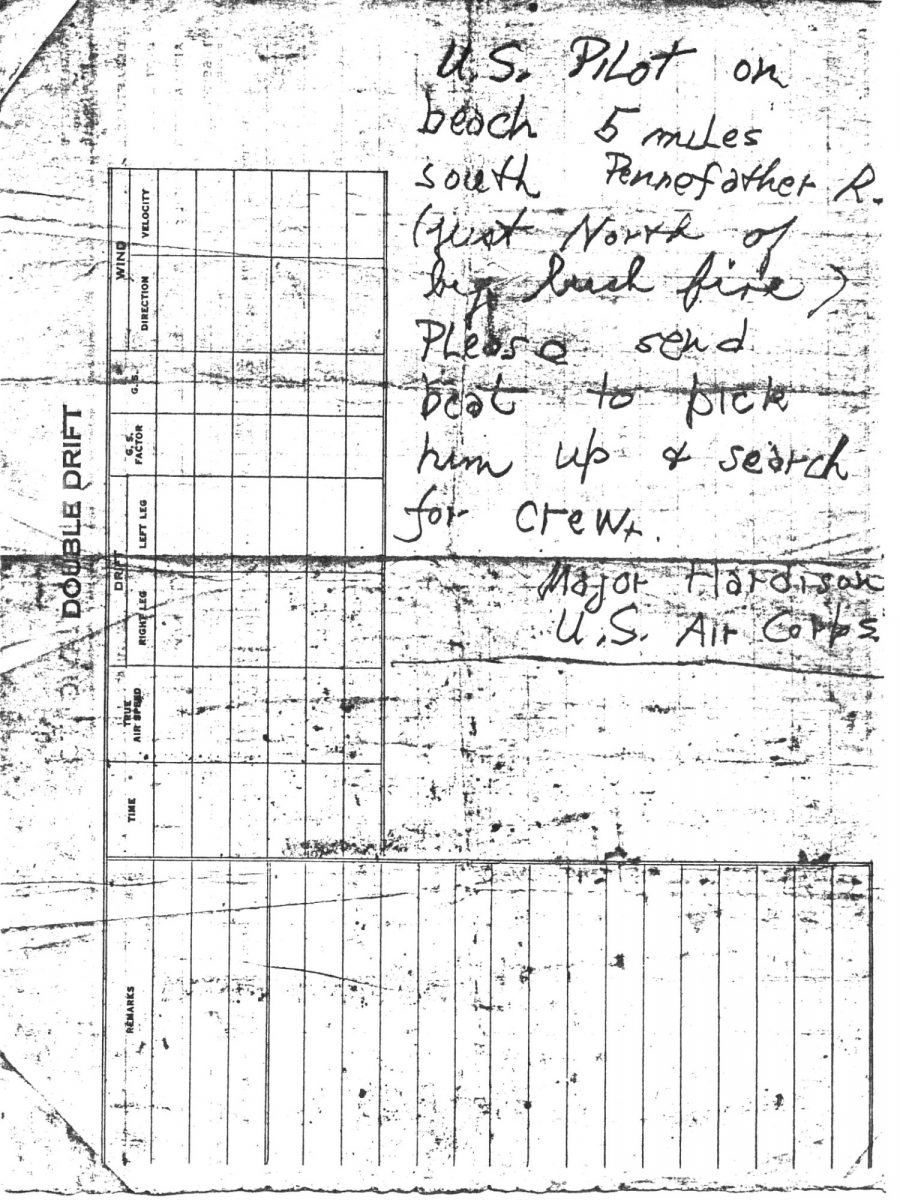
A message scrawled on a navigator’s log sheet and dropped at Weipa Mission by Major Felix Hardison. Image courtesy Winn Family Papers, Cape York Collection, Hibberd Library.
STORY REACHES PARLIAMENT
Later that year, the Queensland Secretary for Health and Home Affairs, Hon. E.M. (Ned) Hanlon, read to the Queensland Parliament a stirring account of the rescue efforts of the Weipa men:
Here is the account given by Jimmy James, the leader of the Weipa rescue party…
We left Weipa in the dinghy on Friday evening [September 18] and sailed across the bay to Duifken Point arriving there about 11pm. The crossing was very rough; we were bailing all the time and all soaking wet.
We hauled the dinghy above high-water mark, and, all loaded with medical supplies, stores, and water, set off up the coast walking and running all night.
[The distance along the coast from Duyfken Point to opposite the crash site is about 32 kilometres!]
Just at daybreak we heard a plane and ran fast just in time to see supplies being dropped on the beach. We saw writing on the sand: ‘Go to others first,’ and an arrow drawn.
We rushed on and saw two men too weak to crawl north from where the writing was. Water was the first thing they asked for. I gave them a little water from the demijohn I had carried all night, and a little brandy, then after a little while more water.
Ian Motton got a fire going and made coffee. We spread some eats before them and tried to ease the pain in one man’s leg.
We made them comfortable and rigged up a shade for them, then went inside to search for another two badly injured. We had to creep and crawl a long way through the undergrowth before we could stand up and walk about.
We saw a bushfire coming, and something white moving in front of it. We ran over and found a man [probably Sergeant George Schmid] crawling, trying to get away from the fire, moving into a scrub, where he thought he would lie down and die.
His face was badly smashed, and his jawbone sticking through.
He cried for water, and after he had some was able to walk slowly with Hector, while the other three of us looked for the other man [Sergeant L. Johnson].
We found him with his head wrapped up to protect him from the smoke and fire.
This man’s leg was broken, and he was in a bad way for water.
We gave him water, and I said, ‘Will you allow us to move you?’ He said ‘How?’ I said, ‘On a stretcher.’ He said ‘Where is it?’ I said, ‘We will make it.’
I broke off two strong saplings, took the man’s parachute and wrapped round the saplings and put him on the stretcher.
He was a big man like Mr MacKenzie [Superintendent of the Aurukun Mission].
I took one end and Ian and Cocoanut 2 [Ralph Cocoanut] took the other.
I kneeled down and raised the handles onto my shoulders.
There are blisters where those handles rubbed.
When we were a quarter mile from the beach we met the Mapoon men with packhorses, and then Mr Cane came with the lugger.
That is Jimmy James’ story.
Mr Winn added: “The Weipa men’s early arrival certainly saved these men from a fearful day and probable death.”
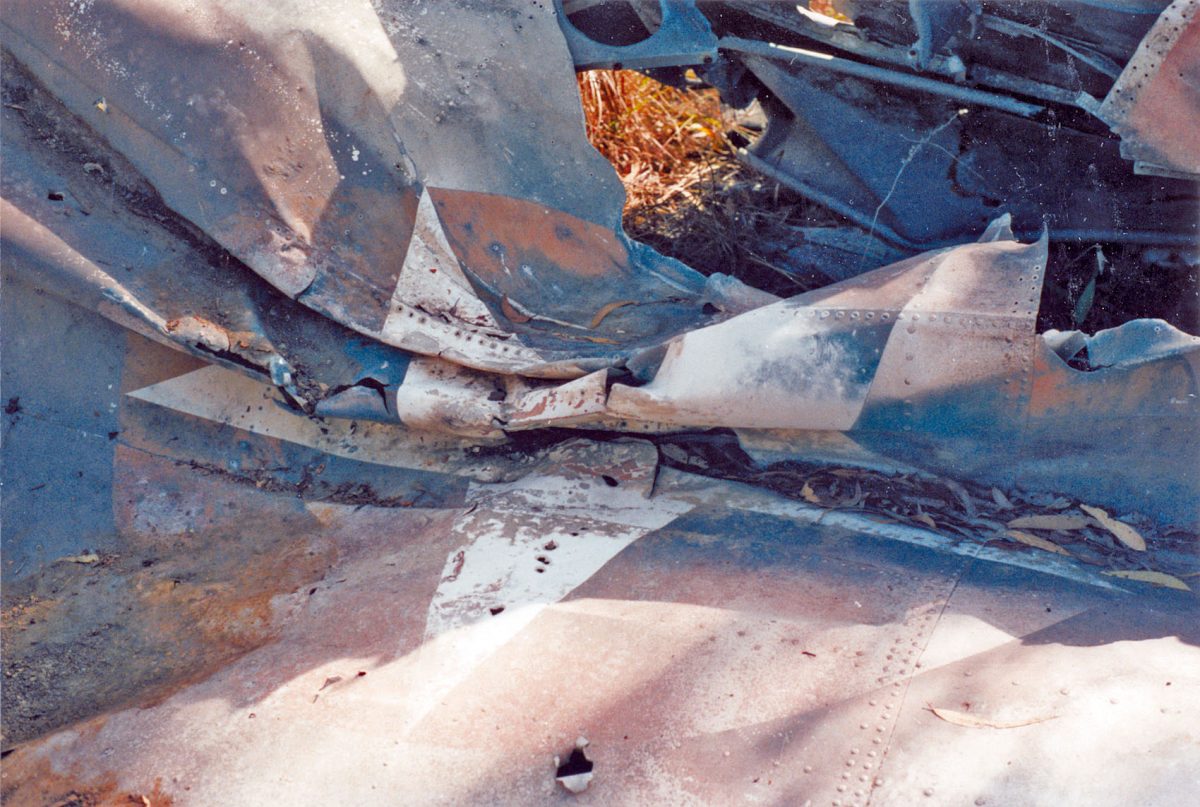
Remains of the fuselage of the B-17 Flying Fortress Bomber 41-2650 showing the USAAF star still visible in 1986. Photo: Geoff Wharton
WATCH SACRIFICED
MEANWHILE, Frank Cane at Mapoon reported later that he had sent his head stockman Benny Charger with four other men on horseback “with instructions that they were to be there at daylight and do what they could in case I could not get there myself.
“Crossing the Coen (Pennefather) river Jerry Hudson lost his watch which was a good one, as they had to swim it with the horses.”
Tim Savo also remembered how the rescuers nearly came to grief:
We went down to Pennefather, camped there until the next morning, we swum our horses across the river…right at the mouth.
We made a canvas boat, put our saddles in and swag in.
[Tim added later in the interview:] We walked our horses from the main beach up to that sand bar.
We unpacked there and made the boat…right where we made the boat, put the boat in, we had a groper [large fish]…so big, eh, it was right under us!].
After the stockmen had departed, Cane assembled emergency supplies and with Mapoon women Rosie (Woodley) and Mabel (probably Mabel Lee), sailed down to the Pennefather River on the mission vessel J.G. Ward.
When they arrived at 110am on Saturday, September 19, Cane found the injured pilot (Burcky) and engineer (Sergeant George Schmid) being cared for by Hector.
He then saw “four men from Weipa Mission there and they were then carrying one of the crew of the plane who had broken his leg in the landing”.
Burcky, Schmid and Chamberlain were brought back to the J.G. Ward where they were fed soup and tea by Rosie and Mabel.
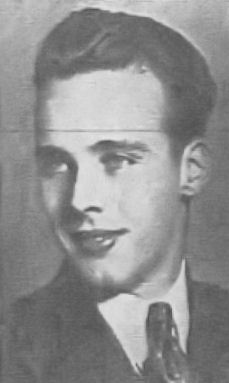
Lieutenant William Francis Meenagh was never found.
AIR SUPPORT ARRIVES
RAAF Sergeant Bob Caldwell continues the story as the RAAF Catalina A24-2 landed on the sea near the J.G. Ward: “We arrived and alighted at 1325 hours.
“There were two men visible on the very narrow beach. I think that the mission lugger had also arrived and we used their dinghy to reach the beach….”
The Catalina searched unsuccessfully for Miller and his companions then returned to Cairns with the first four men, believing that the other four could have walked to Weipa.
Even today with roads and bridges that would be a challenge in the summer heat!
Bob Caldwell wrote in his log-book that the Catalina returned to the Coen (Pennefather) River accompanied by an American officer, collected more searchers from Weipa on the way and arrived at the river at 1430.
Having rowed the Weipa men ashore, the Catalina crew started an aerial search around the river system for the four Americans and Bob remembers that it was “quite a joy when the men were sighted very soon after the search began and on the Mapoon (north) side of the Coen river.
“This was not expected, but the four men were in a small lake and splashed water up to attract our attention”.
It was dark by the time the Americans and their rescuers had reached the Catalina so they were made comfortable for the night.
Next morning, the RAAF crew awoke to find their flying boat stranded on the mud by the long-departed tide.
By 1240 there was enough water to take off and so the weary crews returned to Cairns, while the Mapoon and Weipa men continued searching over a wide area for the missing American.
The sad sequel was relayed to church authorities by Frank Cane, when he wrote that the Captain of the J.G. Ward, [Nicholas Wymara] “returned here Monday with the news that four had been found and that one was still missing these men and boys remained on the job of searching for two weeks and it is now presumed that the other man is dead….”
Despite the best efforts of the Mapoon and Weipa men who had excellent knowledge of the country, Lieutenant Meenagh was never found.
One year after his disappearance, the United States War Department issued a “Finding of Death” which would have assisted with any legal process required for his estate, but would have brought awful sadness to his family in the realisation that despite surviving many dangerous missions against the Japanese, William would not be returning home.
Lieutenant Meenagh’s decorations included the Silver Star, the Distinguished Flying Cross, Air Medal with two oak leaf clusters and a Purple Heart.
Pilot Claude Naylor Burcky (1915-2007) had a long Air Force career and retired with the rank of Colonel in 1970.
The story of the Flying Fortress crew’s rescue is recorded at the war memorials at Mapoon and Napranum.
In 2012, author Michael Musumeci travelled to New York and presented a relic from the aircraft to the Meenagh family.
The American air crew, their brave rescuers from Weipa and Mapoon missions and the RAAF will never be forgotten.
Author Geoff Wharton thanks the family descendants of the rescuers from Napranum and Mapoon who kindly provided their memories, as well as the late Bob Caldwell DFM and Mrs Betty Caldwell, Jack Clarke, Don Egan, John Foss, Mick Isenbert, the late Margaret Little (née Winn), author Michael Musumeci, Chris and Kath Newman, the late Bob Piper (ex-RAAF Historical Section), Jack Riddell, the late Tim Savo, Ted Sturtevant and David Vincent.


